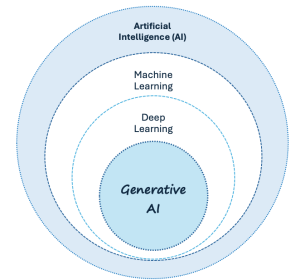Introduction
Generative AI, ChatGPT, and Your Students
By now, almost everyone has heard of ChatGPT. Its website (and later app) crushed records in terms of the briefest length of time needed to amass 100 million users. ChatGPT uses a type of generative Artificial Intelligence (AI) that not only burst onto the scene with amazing speed from relative obscurity (at least for those not already working in the field), but also has continued to evolve rapidly—and by some indications, its development may even be speeding up.

Though ChatGPT may be the first generative AI product many of us used directly, there are a huge variety of new AI products released to the public each week, both as standalone products or integrated into software like Microsoft Office, Adobe Photoshop and others and the presence of AI in these systems and others will only increase in the future. Those of us on the layperson and user side of the process are being told to prepare for constant AI evolution, a future of AI in almost everything we do, regardless of field or discipline, and a need to develop skills that make us ready to adapt and keep adapting to the ever-changing mosaic of AI that awaits us.
Scope, Reach, and Organization of This Book
This book does not explain Generative AI basics, it is assumed that those looking to work with Generative AI in their learning spaces already have this knowledge.
The book is divided into three sections, with titles that give clear descriptions of what the information they contain:
- Activities to Help Students Understand Generative AI
- Activities to Get Students Using Generative AI
- Ideas for using Generative AI to Support Your Teaching Practice
Each section is preceded by a short introduction that gives some important background and rationale. The Activities from the original open textbook have been adapted to be relevant to NSCC courses and student/faculty need.
It is recognized that while some people will read this book cover-to-cover, others may dip into individual activities without reading the framing. For that reason some duplication around common cautions or framing around Generative AI can be expected between activities.
Ethical Considerations and Cautions
As a new technology, there has been both excitement and caution around Generative AI. In this text we try to balance the need/desire to pull an important new technology into learning spaces, while highlighting some of the key concerns that faculty should consider.
Bias and Error
When using Generative AI in an education setting, faculty should be aware of issues of bias and error that can result from the algorithmic responses generated by large language models(LLMs). While we want to recognize the ways this new technology can enhance the learning experience, we don’t want our students to have incorrect or biased information become a part of that learning. For that reason, most activities in this book recommend that faculty (the subject matter experts for their fields) debrief with students to discuss information pulled from Generative AI. If you would like additional assistance around how to do this for learning activities involving generative AI, reach out to the Centre for Teaching and Learning.
Academic Integrity
Academic Integrity is a second big ethical consideration for use of Generative AI. This consideration has many facets including:
- Debate about whether the information fed to LLMs to train them was ethically/legally obtained: some people may feel this means it is not possible to use a product that was created unethically in an ethical manner.
- Concerns about how students are using Generative AI in learning and evaluations and if this constitutes cheating.
- Questions about citation and acknowledgement of AI Generated content.
These questions are not yet answered and will provide good food for discussion (that will help build critical thinking skills) with your students. For student supports, including in-class workshops for Academic Integrity, contact your campus library. For faculty supports, contact the library or the Centre for Teaching and Learning.
Some General Cautions for all Generative AI activities
- You cannot require students to sign up for third party products, although you can present it as an option.
- Always emphasize to students the importance of reading terms of use and privacy information.
- NSCC’s Enterprise license with Microsoft includes Copilot, so students already have access to this product.
- In particular with creative/exploratory topics which can be more subjective, Generative AI may give inconsistent responses. Test your prompt topics before giving them to students to get a sense of the types of responses they will generate.
- Be prepared that students may get suggestions that don’t match your lesson plan and that you may need to discuss these.
Feedback and Growth
It is our hope that this book will grow as more and more faculty embrace using Generative AI with their students. If you have activities that you have developed that you would be interested in sharing with other faculty (and with an Open License), please contact the Centre for Teaching and Learning at ctl@nscc.ca
The same email address can be used for any feedback on the book you would like to share.
NSCC Resources
- Centre for Teaching and Learning’s Teaching Commons Pages on Artificial Intelligence in the Classroom

